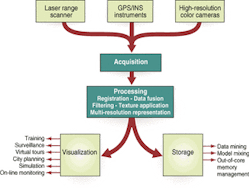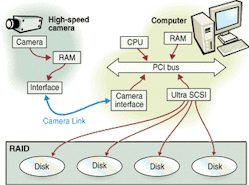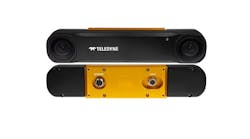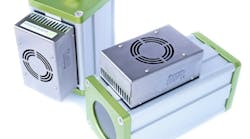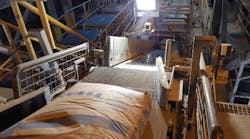Part I: Design of a high-speed video-acquisition and archiving system for university use involves hardware and software challenges and compromises.
By Gary Armstrong and Mongi Abidi
The design of a new high-speed video-acquisition and archiving system supports the research-and-development activities of the University of Tennessee (Knoxville, TN, USA). The system design enables the creation of a mixed reality model (MRM) for enhanced visualization (see Figs. 1 and 2).
The model combines synthetic models of military tanks and trees with digitized models of an existing real-world van and a panoramic backdrop. The van has been modeled using eight range scans from a LMS-Z210 3-D laser range scanner from Riegl USA Inc. (Orlando, FL, USA). The backdrop has been created from 24 digital images that have been registered and stitched together. Data from this model drive the requirements for the acquisition and archiving system.
The LMS-Z210 is a rugged, portable sensor for the rapid acquisition of high-quality three-dimensional (3-D) images under demanding environmental conditions. It provides range, angle, signal amplitude, and target color information via an 8-bit parallel data output that is connected to a personal or notebook computer. The system computer runs the 3D-RiSCAN bundled software package, under Windows XP/2000/NT 4.0/95/98, and performs such tasks as sensor configuration, data acquisition, data visualization, data manipulation, and data archiving.
System design specifications call for the acquisition, processing, and storage of 1280 × 1024-pixel color frames at 500 frames/s for 300 s and an upgrade path to faster cameras at 1000 frames/s when these devices become available. Current high-speed video systems can store high-speed data to internal camera RAM buffers for only a short time. Sustaining a high-speed acquisition system to a storage device for a lengthy period is a demanding requirement that pushes the state of the art.
The design of this high-speed video-acquisition and storage system focuses on the component-selection process needed to achieve target goals. Multiple transfer protocols have been investigated that could rapidly move the imaging data from the camera to the computer and from the computer to a storage medium. The advantages and disadvantages of available hardware and software have been examined.
Design process
Available CMOS-based high-speed camera systems have mandated a careful selection process. Typically, these cameras copy images only to an intermediate buffer in the camera for a short time and then transfer the data to a long-term storage device through a slower interface off-line. Color cameras are on the drawing board for delivering the 1280 × 1024-pixel and 1000-frame/s design goals, but at system design time they were not commercially available. Some cameras can provide 200 to 500 frames/s, but most of them are in alpha and beta testing.
Another challenge involved the delivery of 655 Mbytes/s of data at 500 frames/s to disk storage. This task has required examination of interface standards, computer hardware and software, and disk-storage technologies. Caution is necessary because most bus speeds are specified in burst data rates, not sustained data rates. Because the target speeds of the desired system design push the state-of-the-art in streaming video systems, the university design team has turned to established suppliers with proven high-speed video acquisition products and services in integrated or turnkey video system platforms.
In selecting a turnkey supplier for this project, the design team has explored several factors. The first is a software-development kit that permits the addition of system functions via access to library algorithms. Other factors are technical support features and future development costs. For state-of-the-art video designs, only the turnkey system supplier can solve last-minute design changes, modifications, or updates productively and cost effectively. In this approach, the final video-acquisition and storage system design was able to meet the sustained data-rate requirements for 500 frames/s, storage in excess of 300 Gbytes, time-stamped data, and an upgrade path to faster cameras at 1000 frames/s.
Systems-integrator Maverick Systems (Kingston, TN, USA) was contracted to research and survey commercially available camera systems, industry-standard data interfaces (for example, Camera Link), and available components for integrating the identified camera and data interface to digital storage systems. The company concentrated on finding an integrated solution, but the limited availability of technologies other than alpha or beta quality products, such as for cameras and PCI bus technologies, extended the search to include turnkey systems. Based on search results, Maverick Systems identified the high-speed camera, industry-standard computer interface, computer PCI bus, and disk transfer and storage technologies as critical components of the desired system (see Fig. 3).
High-speed cameras
The system design begins with the search for a 1280 × 1024-pixel color camera that could supply a sustained data rate of 500 frames/s for 300 s to a storage system. Selection of the camera resolution and transfer rate has helped to quantify the amount of data that needs to be stored to disk every second. Transfer speeds, data-streaming capacity, and data storage needs are driven by the number of pixels in a frame, the number of frames per second, and how the color information is encoded.
Most available cameras can sustain a high speed for only a short time. They write data to an internal RAM, and images are downloaded to a PC through any one of several computer interfaces at a slower speed. This permits approximately 1 to 4 s of storage depending on the data rate, array size, pixel size, and internal RAM size. The university video system requires a camera that can capture color images and transfer the data at a sustained data rate to the storage device for 300 s. This demand has mandated a high-speed color camera with sustained data-transfer capabilities.
Both CMOS and CCD cameras have been evaluated.
However, CMOS cameras do not perform as well as CCD cameras in low-light applications, but do outperform CCDs in intense light applications due to their antiblooming ability. Because the university imaging application is targeted for outside use, a CCD camera is desirable. CMOS cameras work fine in bright sunlight but show noticeable degradation in shadows and intermittent cloud cover.
A key camera difference is in the addressing scheme and, therefore, the utilization factor. Noise has driven CMOS manufacturers to place an amplifier at each pixel. This reduces the fill factor (utilization factor) and, therefore, the sensitivity. The reduction in the size of the camera area that is available to capture light has the same effect as increasing the f-stop.
The CCD camera is more desirable for outside applications but does not provide the necessary frame rates. Increasing the frame rate for the CCD camera would have a similar effect as is being experienced by the CMOS camera, a decrease in utilization factor. Until a high-speed CCD with good sensitivity to low light is developed it appears that a CMOS camera is the choice for this system design. In addition, an infrared strobe can be used to supplement the lack of ambient sunlight when using a CMOS camera.
Fast transfer rates
Several CMOS cameras can transfer data at high speeds to an intermediate buffer (internal RAM). After image acquisition is completed, the buffered images are then transferred to the computer or storage media through use of one of several digital transfer protocols. Most cameras can capture images at different resolutions and speeds. For example, the FireWire (IEEE 1394a) transfer protocol can move data at 400 Mbits/s (see table [as pdf]).
After examining available cameras, the design process now moves on to video acquisition and archiving systems. The desired system is one that can meet the data rates and storage requirements of a 1280 × 1024-pixel, 500 frame/s, color camera and also provide an upgrade path for future faster cameras presently under development.
REFERENCES
K. Nice and G. J. Gurevich, "How Digital Cameras Work," www.howstuffworks.com/ digital-camera4.htm
B. Grob, Basic Television and Video Systems, 5th ed., Glencoe McGraw Hill, New York, NY, p. 66
P. B. Denyer, Vision and Imaging Business Unit, ST Microelectronics, "CMOS vs. CCD," www.st.com
In August, Part 2 of Video-system design achieves speed goals will examine how data-transfer protocols, computer backplane bus speeds, and disk-transfer protocols help determine the final video-acquisition and archiving system design.
GARY ARMSTRONG is president, Maverick Systems Inc., Kingston, TN (www.MavSysInc.us), and MONGI ABIDI is professor and director of the Imaging, Robotics, and Intelligent Systems Laboratory, University of Tennessee, Knoxville, TN (imaging.utk.edu).
Info
University of Tennessee Imaging, Robotics, and Intelligent Systems Laboratory imaging.utk.edu
Maverick Systems Inc. www.MavSysInc.us
Riegl USA Inc. www.rieglusa.com
Click here to download "High-Speed CMOS Cameras" pdf. {pdf size=128k}

